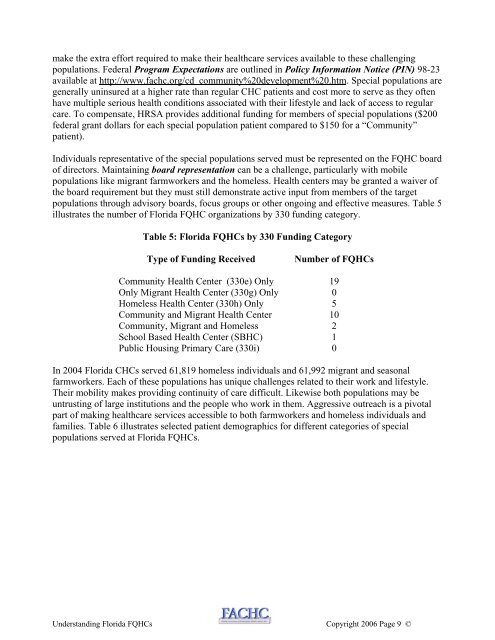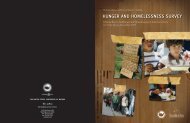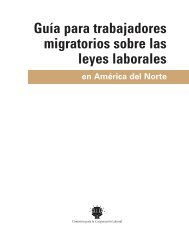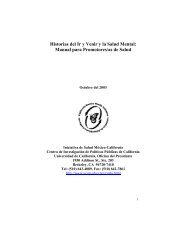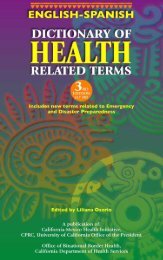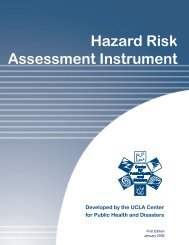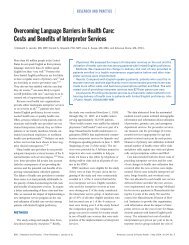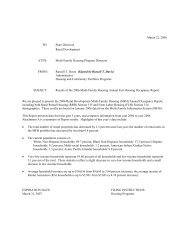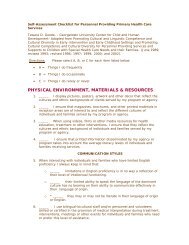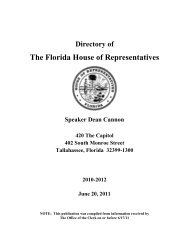Guide to Understanding Florida's FQHCs and 330 Expansion ...
Guide to Understanding Florida's FQHCs and 330 Expansion ...
Guide to Understanding Florida's FQHCs and 330 Expansion ...
Create successful ePaper yourself
Turn your PDF publications into a flip-book with our unique Google optimized e-Paper software.
make the extra effort required <strong>to</strong> make their healthcare services available <strong>to</strong> these challenging<br />
populations. Federal Program Expectations are outlined in Policy Information Notice (PIN) 98-23<br />
available at http://www.fachc.org/cd_community%20development%20.htm. Special populations are<br />
generally uninsured at a higher rate than regular CHC patients <strong>and</strong> cost more <strong>to</strong> serve as they often<br />
have multiple serious health conditions associated with their lifestyle <strong>and</strong> lack of access <strong>to</strong> regular<br />
care. To compensate, HRSA provides additional funding for members of special populations ($200<br />
federal grant dollars for each special population patient compared <strong>to</strong> $150 for a “Community”<br />
patient).<br />
Individuals representative of the special populations served must be represented on the FQHC board<br />
of direc<strong>to</strong>rs. Maintaining board representation can be a challenge, particularly with mobile<br />
populations like migrant farmworkers <strong>and</strong> the homeless. Health centers may be granted a waiver of<br />
the board requirement but they must still demonstrate active input from members of the target<br />
populations through advisory boards, focus groups or other ongoing <strong>and</strong> effective measures. Table 5<br />
illustrates the number of Florida FQHC organizations by <strong>330</strong> funding category.<br />
Table 5: Florida <strong>FQHCs</strong> by <strong>330</strong> Funding Category<br />
Type of Funding Received<br />
Number of <strong>FQHCs</strong><br />
Community Health Center (<strong>330</strong>e) Only 19<br />
Only Migrant Health Center (<strong>330</strong>g) Only 0<br />
Homeless Health Center (<strong>330</strong>h) Only 5<br />
Community <strong>and</strong> Migrant Health Center 10<br />
Community, Migrant <strong>and</strong> Homeless 2<br />
School Based Health Center (SBHC) 1<br />
Public Housing Primary Care (<strong>330</strong>i) 0<br />
In 2004 Florida CHCs served 61,819 homeless individuals <strong>and</strong> 61,992 migrant <strong>and</strong> seasonal<br />
farmworkers. Each of these populations has unique challenges related <strong>to</strong> their work <strong>and</strong> lifestyle.<br />
Their mobility makes providing continuity of care difficult. Likewise both populations may be<br />
untrusting of large institutions <strong>and</strong> the people who work in them. Aggressive outreach is a pivotal<br />
part of making healthcare services accessible <strong>to</strong> both farmworkers <strong>and</strong> homeless individuals <strong>and</strong><br />
families. Table 6 illustrates selected patient demographics for different categories of special<br />
populations served at Florida <strong>FQHCs</strong>.<br />
<strong>Underst<strong>and</strong>ing</strong> Florida <strong>FQHCs</strong> Copyright 2006 Page 9 ©


